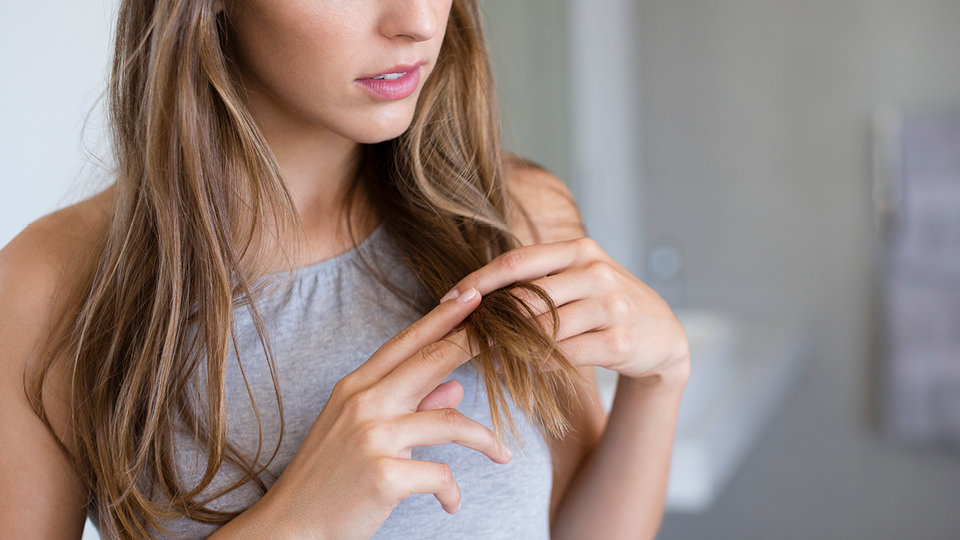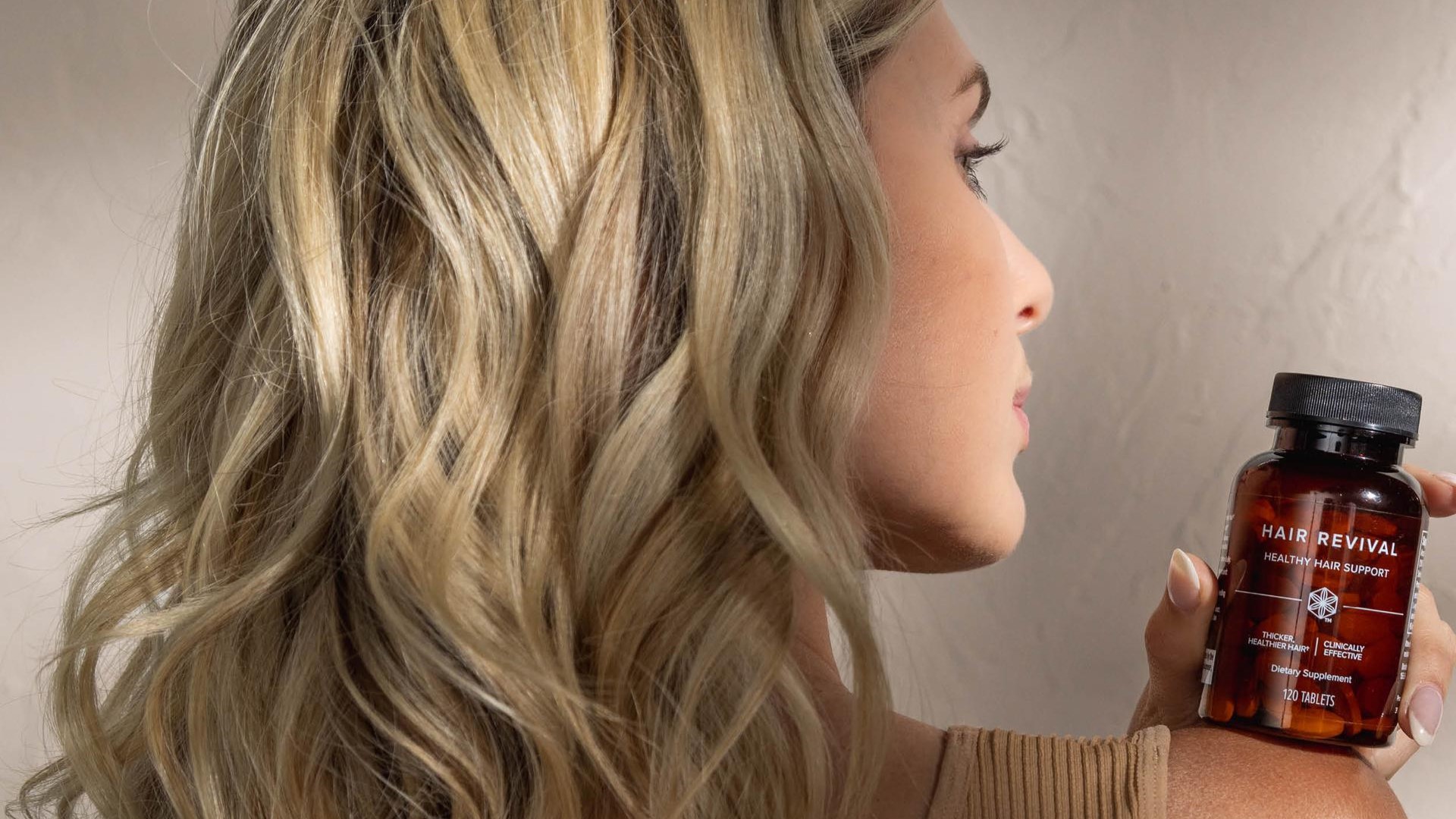Finding a large amount of hair in your hairbrush or in the shower drain can be alarming, to say the least, but identifying the possible causes of thinning hair can help to make the problem more manageable.
What’s Normal: The Hair Cycle
It’s normal to shed about 100 hairs a day, whether they drop off unnoticed or shed when brushing or washing your hair (1). Hair follicles follow a natural cycle that starts with a period of growth known as the anagen phase. This growth period is followed by a short transition, or catagen phase, and a period of rest known as the telogen phase. When the cycle starts over with a new growth phase, the old strand of hair is pushed out of the follicle and sheds in what is sometimes referred to as the exogen phase (2).
At any one time, most of your follicles are in the growth phase. In part, this is because the growth phase lasts about 3 to 5 years for hair follicles on your scalp. The transition phase only lasts a couple of weeks while the resting phase lasts around three months. Shorter hairs, like eyebrows, for example, have a very short growth phase, about 30 days, and a longer resting phase (2).
Common Causes of Thinning Hair
If you start to notice a lot more shed strands than usual, it doesn’t necessarily mean that anything is wrong, but considering common causes of thinning hair is an important first step.
Poor Nutrition
Many nutrients support hair growth and an unbalanced diet can visibly impact hair. Low levels of any one of the nutrients that the body needs to build new hair can lead to stalled growth, increased shedding, and changes in the quality of hair growth.
For example, iron deficiency results in coarse and brittle hair growth. Inadequate levels of vitamin D or biotin can increase hair shedding. Protein is vital for healthy hair growth and too little of this nutrient can result in thin, brittle hair and a reduction in hair’s natural color (3). Improved nutrition is needed to resolve this cause of thinning hair.
Natural Aging
Age-related changes in hair growth are easy to see. Not only does hair lose its color, turning white or grey, but it also becomes thinner and drier as time passes. Many of the factors that contribute to the aging process throughout the body like oxidative stress and DNA damage impact hair growth, too (4).
Strong antioxidant nutrients like selenium provide key elements in the body’s natural defenses against oxidative stress and DNA damage (5). Some research suggests that oxidative stress may be one of the critical drivers of prematurely graying hair (6, 7). While age-related changes in hair growth and color are natural, choosing antioxidant-rich foods like fruits, vegetables, whole grains, and nuts can promote healthy hair at any age.
Stress
Both physical and mental stress can have a major impact on hair growth. Telogen effluvium is the medical term for stress-related hair shedding. It typically occurs anywhere from 2 to 5 months after a stressful event and can result in the loss of up to 70% of the hair on the scalp. Additionally, many new moms experience a special type of stress-related hair loss called telogen gravidarum a few months after their child is born (8).
Stress-related hair shedding can be acute, particularly after a single stressful event, but it can also be chronic, resulting in thinning hair from increased shedding over time. Common contributors include severe emotional stress, along with physical stressors like illness, fever, or injury (8). Thankfully, hair starts growing back on its own soon after it’s shed during telogen effluvium. While losing hair is reason enough to feel stressed out, finding ways to manage and adapt to stress can ease excess shedding from chronic telogen effluvium.
Get Growing
No matter the reason for thinning hair, good nutrition is an essential component for supporting healthy new growth. Many nutrients including protein, vitamins, and minerals are necessary for building new hair while antioxidant nutrients defend against factors that lead to premature aging in hair.
An unbalanced diet, natural aging, and stress are three common causes of thinning hair, but many other factors can contribute, too. Hormonal changes, health conditions, and medical treatments also have the potential to impact your hair growth and increase shedding (1). Talking to your doctor or getting an assessment from a dermatologist can help you get to the root of the problem and give you the information you need to manage thinning hair.
References
- Phillips TG, Slomiany WP, Allison R. Hair Loss: Common Causes and Treatment. Am Fam Physician. 2017;96(6):371-378.
- Plowman JE, Harland DP. The Follicle Cycle in Brief. Adv Exp Med Biol. 2018;1054:15-17. doi:10.1007/978-981-10-8195-8_2
- Rushton DH. Nutritional factors and hair loss. Clin Exp Dermatol. 2002;27(5):396-404.
- Turner GA, Bhogal RK. Hair and Aging. Skinmed. 2016;14(5):338-343.
- Tapiero H, Townsend DM, Tew KD. The antioxidant role of selenium and seleno-compounds. Biomed Pharmacother. 2003;57(3-4):134-144. doi:10.1016/s0753-3322(03)00035-0
- Triwongwaranat D, Thuangtong R, Arunkajohnsak S. A review of the etiologies, clinical characteristics, and treatment of canities. Int J Dermatol. 2019;58(6):659-666. doi:10.1111/ijd.14399
- Saxena S, Gautam RK, Gupta A, et al. Evaluation of Systemic Oxidative Stress in Patients with Premature Canities and Correlation of Severity of Hair Graying with the Degree of Redox Imbalance. Int J Trichology. 2020;12(1):16-23. doi:10.4103/ijt.ijt_99_19
- Asghar F, Shamim N, Farooque U, Sheikh H, Aqeel R. Telogen Effluvium: A Review of the Literature. Cureus. 2020;12(5):e8320. doi:10.7759/cureus.8320





